The Role of Weak C–H···X (X = O, π) Interactions in Three 1-Hydroxy-2-naphthoic Acid Cocrystals with N-Containing Heteroaromatics: Structural Characterization and Synthon Cooperation
Abstract
1. Introduction
2. Materials and Methods
2.1. General Materials and Physical Characterization
2.2. Syntheses of the Complexes 1–3
2.3. X-ray Crystallography
3. Results and Discussion
3.1. Molecular and Supramolecular Structural Descriptions of Compounds 1–3
3.2. Thermal Stability
3.3. FT–IR
4. Conclusions
Supplementary Materials
Author Contributions
Funding
Data Availability Statement
Conflicts of Interest
References
- Desiraju, G.R. Crystal engineering: From molecule to crystal. J. Am. Chem. Soc. 2013, 135, 9952–9967. [Google Scholar] [CrossRef] [PubMed]
- Boese, R.; Bläser, D.; Jansen, G. Synthesis and theoretical characterization of an acetylene-ammonia cocrystal. J. Am. Chem. Soc. 2009, 131, 2104–2106. [Google Scholar] [CrossRef] [PubMed]
- Cinčić, D.; Friščić, T.; Jones, W. A stepwise mechanism for the mechanochemical synthesis of halogen-bonded cocrystal architectures. J. Am. Chem. Soc. 2008, 130, 7524–7525. [Google Scholar] [CrossRef] [PubMed]
- Mandala, V.S.; Loewus, S.J.; Mehta, M.A. Monitoring cocrystal formation via in situ solid-state NMR. J. Phys. Chem. Lett. 2014, 5, 3340–3344. [Google Scholar] [CrossRef]
- Zhang, T.; Yang, Y.; Zhao, X.; Jia, J.; Su, H.; He, H.; Gu, J.; Zhu, G. Dissolution and pharmacokinetic properties of two paliperidone cocrystals with 4-hydroxybenzoic and 4-aminobenzoic acid. CrystEngComm 2014, 16, 7667–7672. [Google Scholar] [CrossRef]
- Sugandha, K.; Kaity, S.; Mukherjee, S.; Isaac, J.; Ghosh, A. Solubility enhancement of ezetimibe by a cocrystal engineering technique. Cryst. Growth Des. 2014, 14, 4475–4486. [Google Scholar] [CrossRef]
- Aitipamula, S.; Banerjee, R.; Bansal, A.K.; Biradha, K.; Cheney, M.L.; Choudhury, A.R.; Desiraju, G.R.; Dikundwar, A.G.; Dubey, R.; Duggirala, N.; et al. Polymorphs, salts, and cocrystals: What’s in a name. Cryst. Growth Des. 2012, 12, 2147–2152. [Google Scholar] [CrossRef]
- Wheeler, S.E.; Seguin, T.J.; Guan, Y.F.; Doney, A.C. Noncovalent interactions in organocatalysis and the prospect of computational catalyst design. Acc. Chem. Res. 2016, 49, 1061–1069. [Google Scholar] [CrossRef]
- Riffet, V.; García, J.C.; Carrasco, J.; Calatayud, M. Alkali ion incorporation into V2O5: A noncovalent interactions analysis. J. Phys. Chem. C 2016, 120, 4259–4265. [Google Scholar] [CrossRef]
- Dethlefs, K.M.; Hobza, P. Noncovalent interactions: A challenge for experiment and theory. Chem. Rev. 2000, 100, 143–167. [Google Scholar] [CrossRef]
- Johnson, E.R.; Keinan, S.; Sánchez, P.M.; García, J.C.; Cohen, A.J.; Yang, W.T. Revealing noncovalent interactions. J. Am. Chem. Soc. 2010, 132, 6498–6506. [Google Scholar] [CrossRef]
- Sharma, C.V.K.; Clearfield, A. Three-dimensional hexagonal structures from a novel self-complementary molecular building block. J. Am. Chem. Soc. 2000, 122, 4394–4402. [Google Scholar] [CrossRef]
- Aakeröy, C.B.; Chopade, P.D.; Ganser, C.; Desper, J. Facile synthesis and supramolecular chemistry of hydrogen bond/halogen bond-driven multi-tasking tectons. Chem. Commun. 2011, 47, 4688–4690. [Google Scholar] [CrossRef]
- Wang, L.; Xue, R.; Xu, L.; Lu, X.; Chen, R.; Tao, X. Hydrogen-bonding directed cocrystallization of flexible piperazine with hydroxybenzoic acid derivatives: Structural diversity and synthon prediction. Sci. China. Chem. 2012, 55, 1228–1235. [Google Scholar] [CrossRef]
- Desiraju, G.R. Reflections on the hydrogen bond in crystal engineering. Cryst. Growth Des. 2011, 11, 896–898. [Google Scholar] [CrossRef]
- Wagner, B.D. Hydrogen bonding of excited states in supramolecular host–guest inclusion complexes. Phys. Chem. Chem. Phys. 2012, 14, 8825–8835. [Google Scholar] [CrossRef] [PubMed]
- Wang, L.; Hu, Y.; Wang, W.; Liu, F.; Huang, K. Energetic multi-component molecular solids of tetrafluoroterephthalic acid with some aza compounds by strong hydrogen bonds and weak intermolecular interactions of C-H/F and C-H/O. CrystEngComm 2014, 16, 4142–4161. [Google Scholar] [CrossRef]
- Schultheiss, N.; Lorimer, K.; Wolfe, S.; Desper, J. Molecular networks created by charge-assisted hydrogen bonding in phosphonate; phosphate; and sulfonate salts of bis(amidines). CrystEngComm 2010, 12, 742–749. [Google Scholar] [CrossRef]
- Tsai, S.C.; Lin, Y.C.; Lin, E.L.; Chiang, Y.W.; Kuo, S.W. Hydrogen bonding strength effect on self-assembly supramolecular structures of diblock copolymer/homopolymer blends. Polym. Chem. 2016, 7, 2395–2409. [Google Scholar] [CrossRef]
- Jones, A.O.F.; Leech, C.K.; McIntyre, G.J.; Wilson, C.C.; Thomas, L.H. Engineering short; strong hydrogen bonds in urea di-carboxylic acid complexes. CrystEngComm 2014, 16, 8177–8184. [Google Scholar] [CrossRef]
- Dai, Z.H.; Qiang, L.; Tang, L.M.; Guo, B.H. A novel supramolecular polymer fabricated via stronger hydrogen-bonding interactions between substituted amide groups: Design; synthesis; properties and mechanism. RSC Adv. 2015, 5, 84104–84112. [Google Scholar] [CrossRef]
- Nishio, M.; Umezawa, Y.; Fantini, J.; Weiss, M.S.; Chakrabarti, P. CH-p hydrogen bonds in biological macromolecules. Phys. Chem. Chem. Phys. 2014, 16, 12648–12683. [Google Scholar] [CrossRef] [PubMed]
- Helttunen, K.; Lehtovaara, L.; Häkkinen, H.; Nissinen, M. Crystal structures and density functional theory calculations of o- and p-Nitroaniline derivatives: Combined effect of hydrogen bonding and aromatic interactions on dimerization energy. Cryst. Growth Des. 2013, 13, 3603–3612. [Google Scholar] [CrossRef]
- Tiefenbacher, K.; Rebek, J. Selective stabilization of self-assembled hydrogen-bonded molecular capsules through π−π interactions. J. Am. Chem. Soc. 2012, 134, 2914–2917. [Google Scholar] [CrossRef] [PubMed]
- Altheimer, B.D.; Pagola, S.; Zeller, M.; Mehta, M.A. Mechanochemical conversions between crystalline polymorphs of a complex organic solid. Cryst. Growth Des. 2013, 13, 3447–3453. [Google Scholar] [CrossRef]
- Loots, L.; Wahl, H.; Westhuizen, L.; Haynes, D.A.; Roex, T. Interconversion between different stoichiometric forms of a three-component crystal via liquid-assisted grinding. Chem. Commun. 2012, 48, 11507–11509. [Google Scholar] [CrossRef]
- Tothadi, S.; Joseph, S.; Desiraju, G.R. Synthon modularity in cocrystals of 4-bromobenzamide with n-alkanedicarboxylic acids: Type I and type II halogen···halogen interactions. Cryst. Growth Des. 2013, 13, 3242–3254. [Google Scholar] [CrossRef]
- Prohens, R.; Portell, A.; Font-Bardia, M.; Bauzá, A.; Frontera, A. Experimental and theoretical study of aromaticity effects in the solid state architecture on squaric acid derivatives. Cryst. Growth Des. 2014, 14, 2578–2587. [Google Scholar] [CrossRef]
- Kim, K.S.; Karthikeyan, S.; Singh, N.J. How different are aromatic π interactions from aliphatic π interactions and non-π stacking interactions? J. Chem. Theory Comput. 2011, 7, 3471–3477. [Google Scholar] [CrossRef]
- Putta, A.; Mottishaw, J.D.; Wang, Z.H.; Sun, H. Rational design of lamellar π-π stacked organic crystalline materials with short interplanar distance. Cryst. Growth Des. 2014, 14, 350–356. [Google Scholar] [CrossRef]
- Smith, M.G.; Lemmerer, A. The photodimerization of Schiff bases: Synthesis and crystal structures of benzophenone azines and their weak CH···π interactions. J. Mol. Struct. 2019, 1179, 132–144. [Google Scholar] [CrossRef]
- Krishna, G.R.; Devarapalli, R.; Lal, G.; Redd, C.M. Mechanically flexible organic crystals achieved by introducing weak interactions in structure: Supramolecular shape synthons. J. Am. Chem. Soc. 2016, 138, 13561–13567. [Google Scholar] [CrossRef]
- Ebenezer, S.; Muthiah, P.T. Design of co-crystals/salts of aminopyrimidines and carboxylic acids through recurrently occurring synthons. Cryst. Growth Des. 2012, 12, 3766–3785. [Google Scholar] [CrossRef]
- Hathwar, V.R.; Thakur, T.S.; Dubey, R.; Pavan, M.S.; Guru, R.T.N.; Desiraju, G.R. Extending the supramolecular synthon based fragment approach (SBFA) for transferability of multipole charge density parameters to monofluorobenzoic acids and their cocrystals with isonicotinamide: Importance of C-H···O.; C-H···F; and F···F intermolecular regions. J. Phys. Chem. A 2011, 115, 12852–12863. [Google Scholar] [PubMed]
- Khan, M.; Enkelmann, V.; Brunklaus, G. Heterosynthon mediated tailored synthesis of pharmaceutical complexes: A solid-state NMR approach. CrystEngComm 2011, 13, 3213–3223. [Google Scholar] [CrossRef]
- Sanphui, P.; Babu, N.J.; Nangia, A. Temozolomide cocrystals with carboxamide coformers. Cryst. Growth Des. 2013, 13, 2208–2219. [Google Scholar] [CrossRef]
- Ivasenko, O.; Perepichka, D.F. Mastering fundamentals of supramolecular design with carboxylic acids. Common lessons from X-ray crystallography and scanning tunneling microscopy. Chem. Soc. Rev. 2011, 40, 191–206. [Google Scholar] [CrossRef] [PubMed]
- Wang, L.; Xu, L.; Xue, L.; Lu, X.; Chen, R.; Tao, X. Cocrystallization of N-donor type compounds with 5-sulfosalicylic acid: The effect of hydrogen-bonding supramolecular architectures. Sci. China Chem. 2012, 55, 138–144. [Google Scholar] [CrossRef]
- Duggirala, N.K.; Wood, G.P.; Fischer, A.; Wojtas, Ł.; Perry, M.L.; Zaworotko, M.J. Hydrogen bond hierarchy: Persistent phenol···chloride hydrogen bonds in the presence of carboxylic acid moieties. Cryst. Growth Des. 2015, 15, 4341–4354. [Google Scholar] [CrossRef]
- Xing, P.; Li, Q.; Li, Y.; Wang, K.; Zhang, Q.; Wang, L. Organic salts formed by 2,4,6-triaminopyrimidine and selected carboxylic acids via a variety of hydrogen bonds: Synthons cooperation; and crystal structures. J. Mol. Struct. 2017, 1136, 59–68. [Google Scholar] [CrossRef]
- Mukherjee, A.; Desiraju, G.R. Combinatorial exploration of the structural landscape of acide-pyridine cocrystals. Cryst. Growth Des. 2014, 14, 1375–1385. [Google Scholar] [CrossRef]
- Ejarque, D.; Calvet, T.; Font-Bardia, M.; Pons, J. Cocrystals Based on 4,4′-bipyridine: Influence of Crystal Packing on Melting Point. Crystals 2021, 11, 191. [Google Scholar] [CrossRef]
- Cruz-Cabeza, A.J. Acid–base crystalline complexes and the p K a rule. CrystEngComm 2012, 14, 6362–6365. [Google Scholar] [CrossRef]
- Braga, D.; Grepioni, F. Reactions Between or Within Molecular Crystals. Angew. Chem. Int. Ed. 2004, 43, 4002–4011. [Google Scholar] [CrossRef] [PubMed]
- Hoskins, B.F.; Robson, R.; Slizys, D.A. An infinite 2D polyrotaxane network in Ag2(bix)3(NO3)2 (bix = 1;4-Bis(imidazol-1-ylmethyl)benzene). J. Am. Chem. Soc. 1997, 119, 2952–2953. [Google Scholar] [CrossRef]
- Sheldrick, G.M. SHELXS-97. Program for the Solution of Crystal Structures; University of Göttingen: Göttingen, Germany, 1997. [Google Scholar]
- Zaltariov, M.F.; Cazacu, M.; Shova, S.; Vlad, A.; Stoica, L.; Hamciuc, E. Hydrogen-bonded supramolecular polymers containing dimethylsilane groups: Synthesis, crystal structure, and characterization. J. Polym. Sci. Pol. Chem. 2012, 50, 3775–3787. [Google Scholar] [CrossRef]
- Zaltariov, M.F.; Filip, D.; Varganici, C.D.; Macocinschi, D. ATR-FTIR and thermal behavior studies of new hydrogel formulations based on hydroxypropyl methylcellulose/poly (acrilic acid) polymeric blends. Cell. Chem. Technol. 2018, 52, 619–631. [Google Scholar]
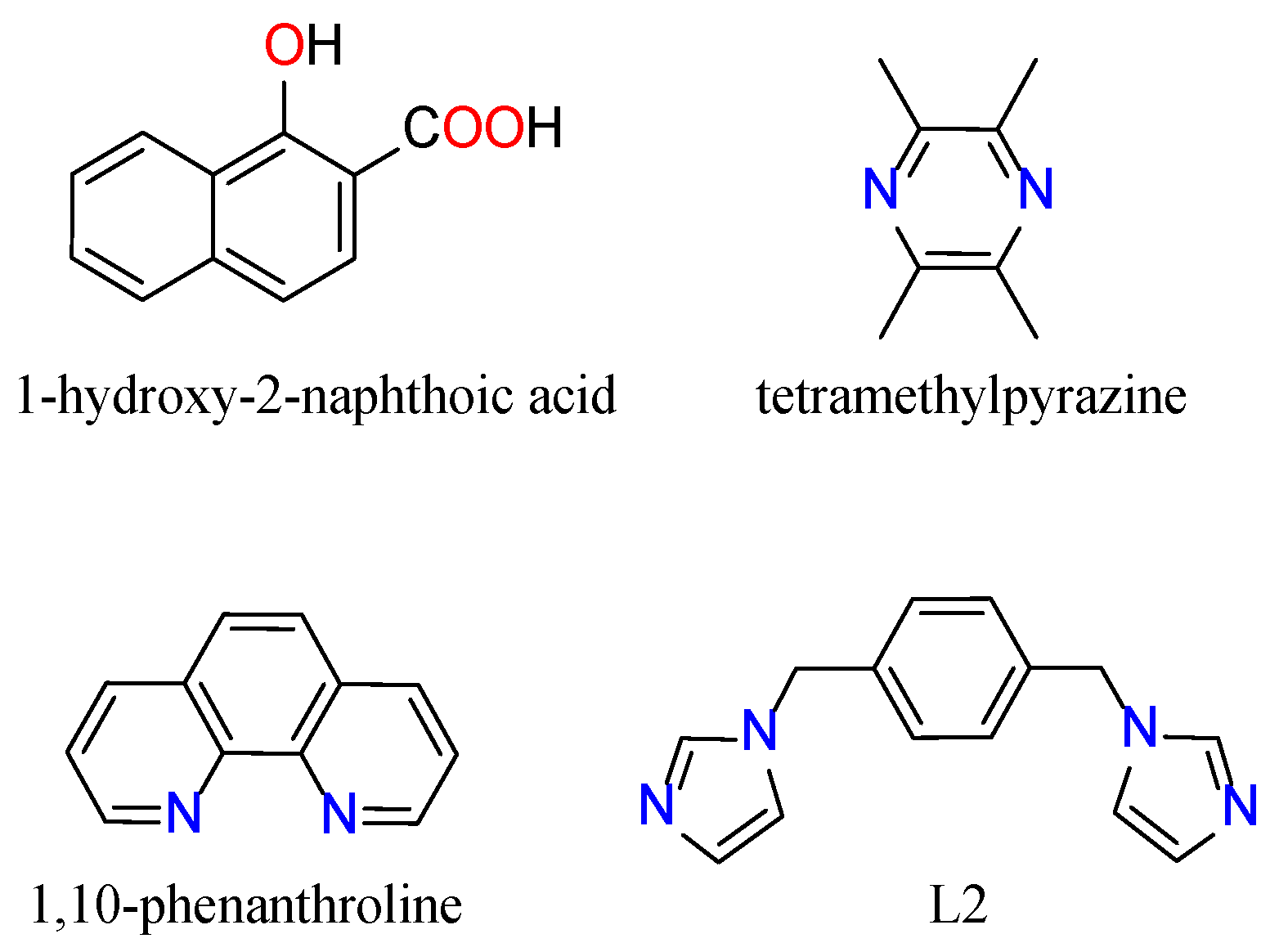
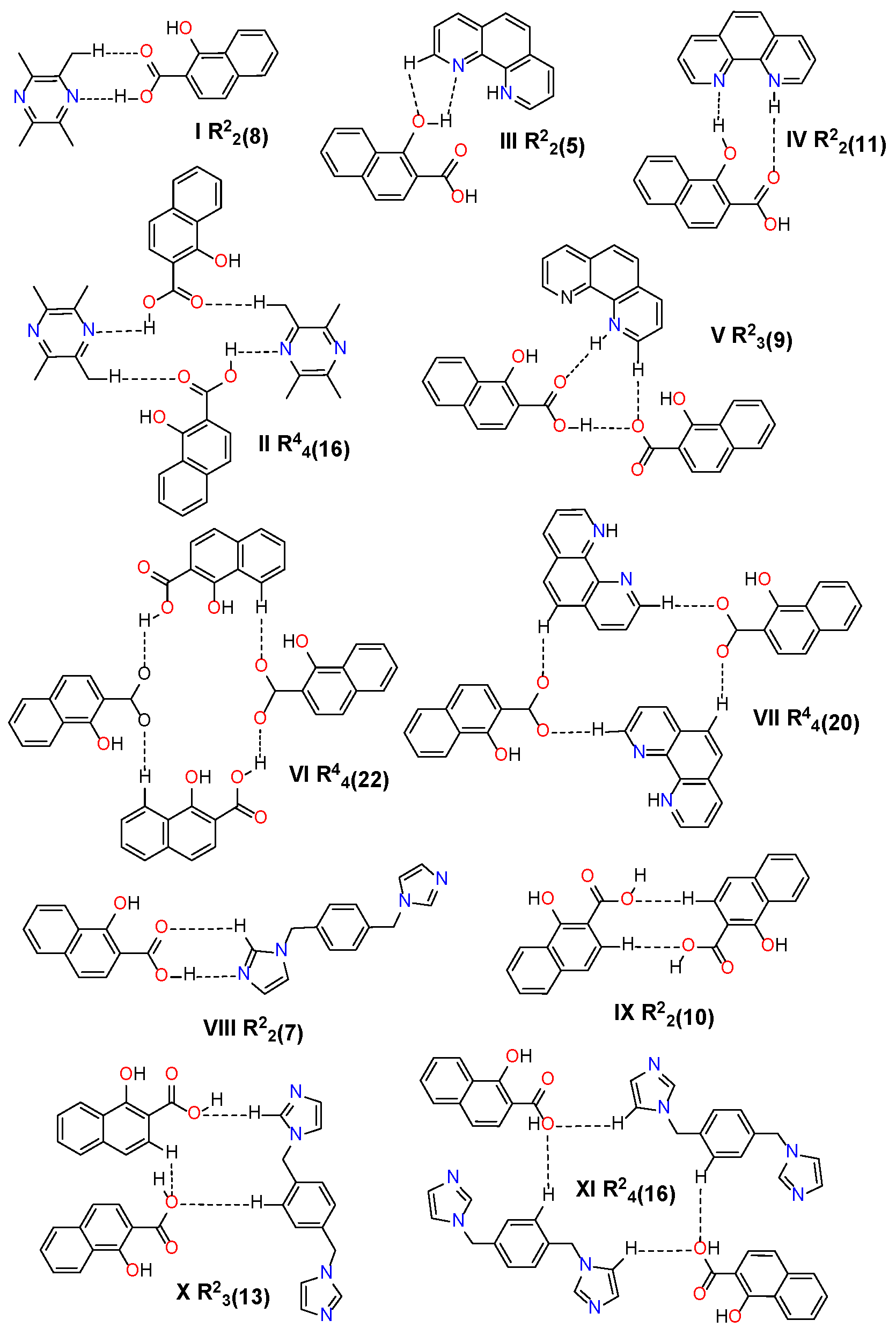
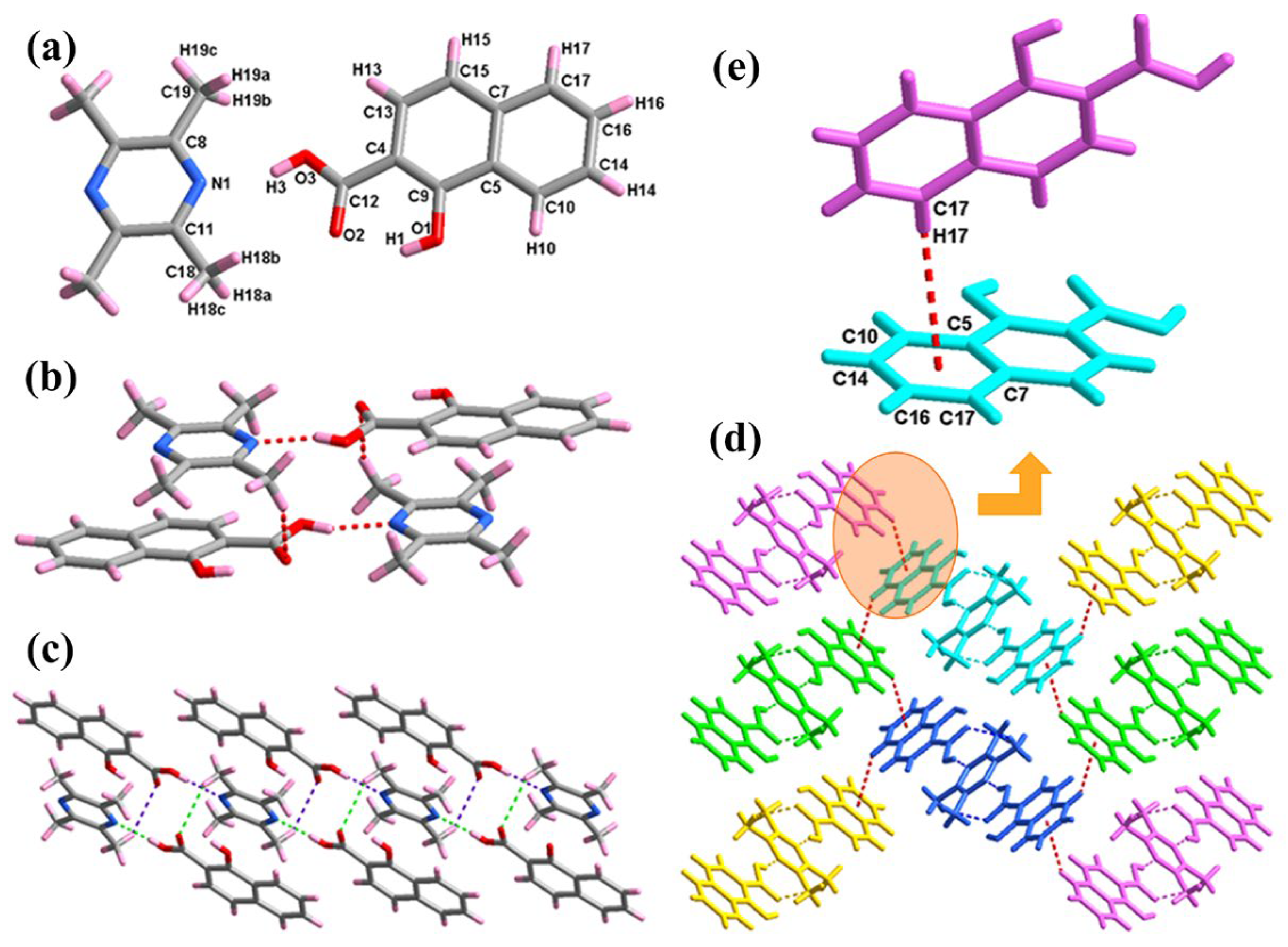
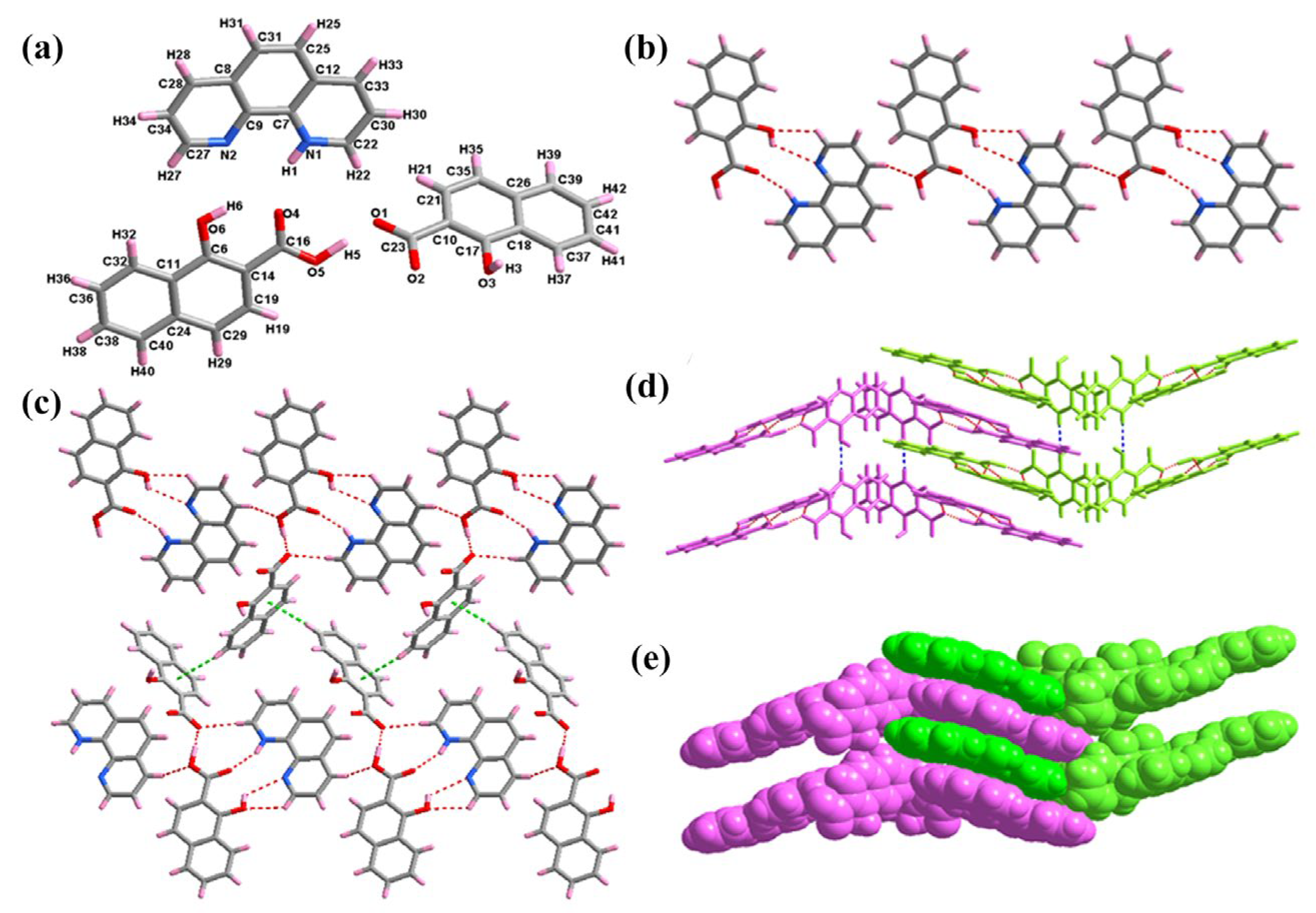
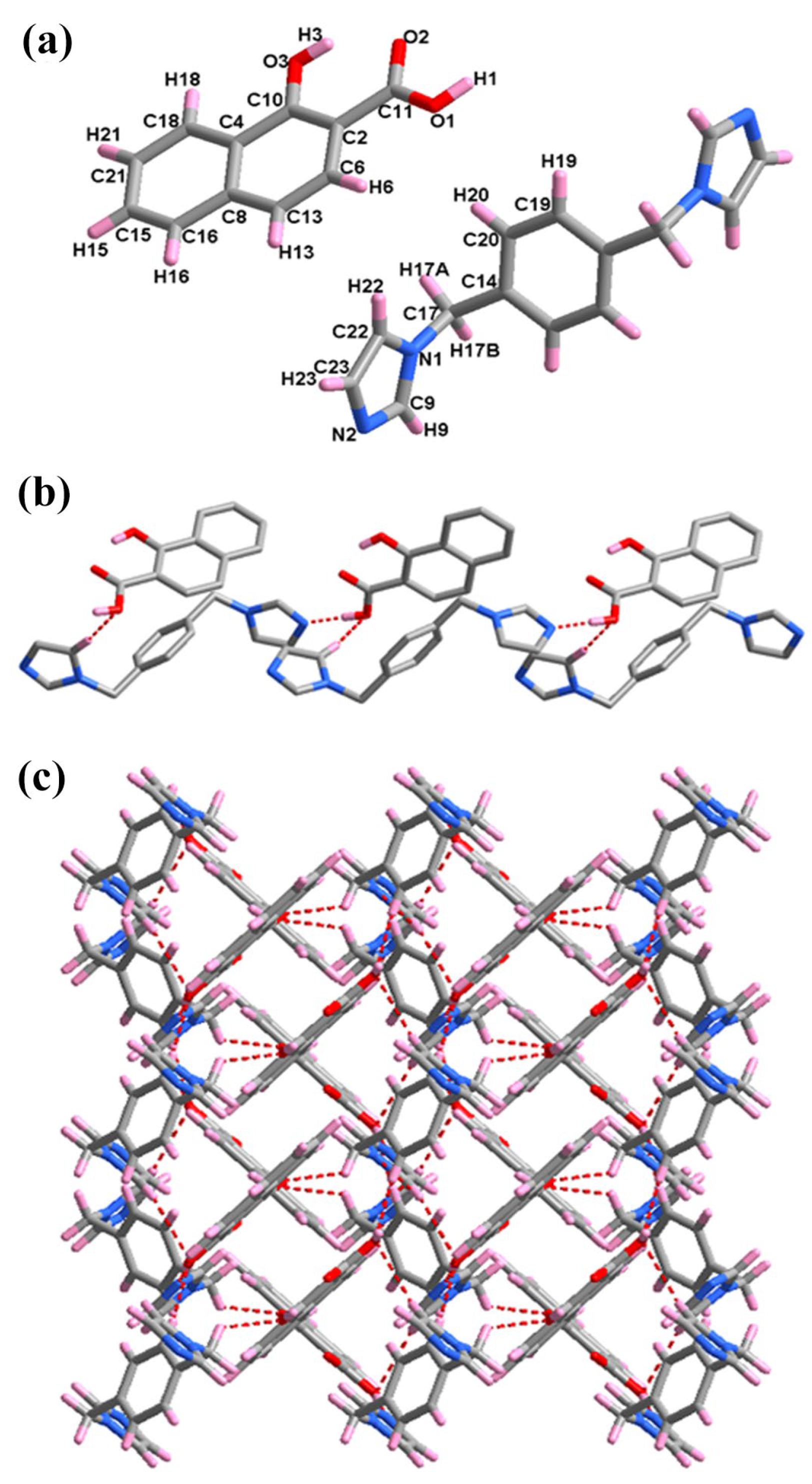
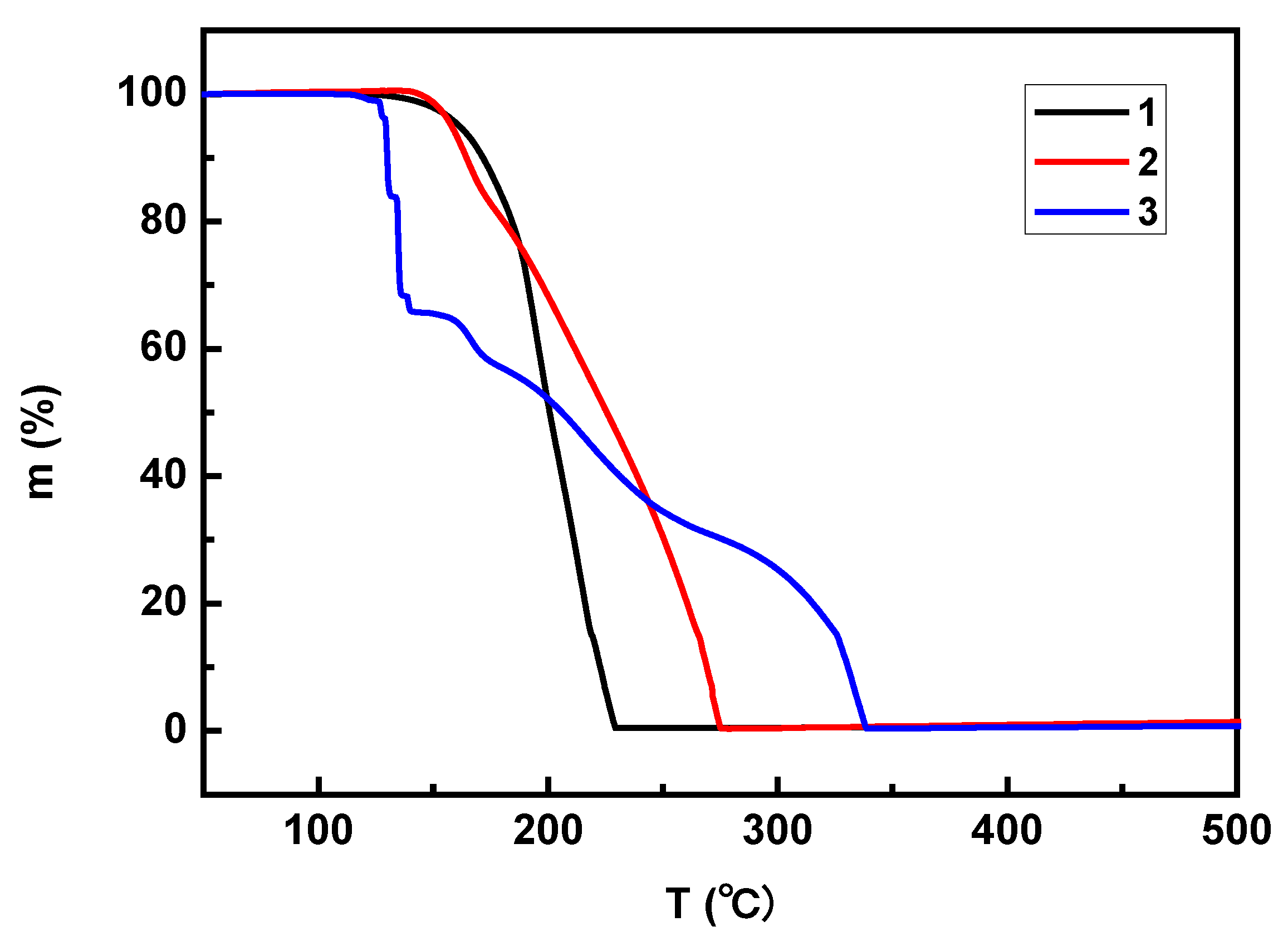
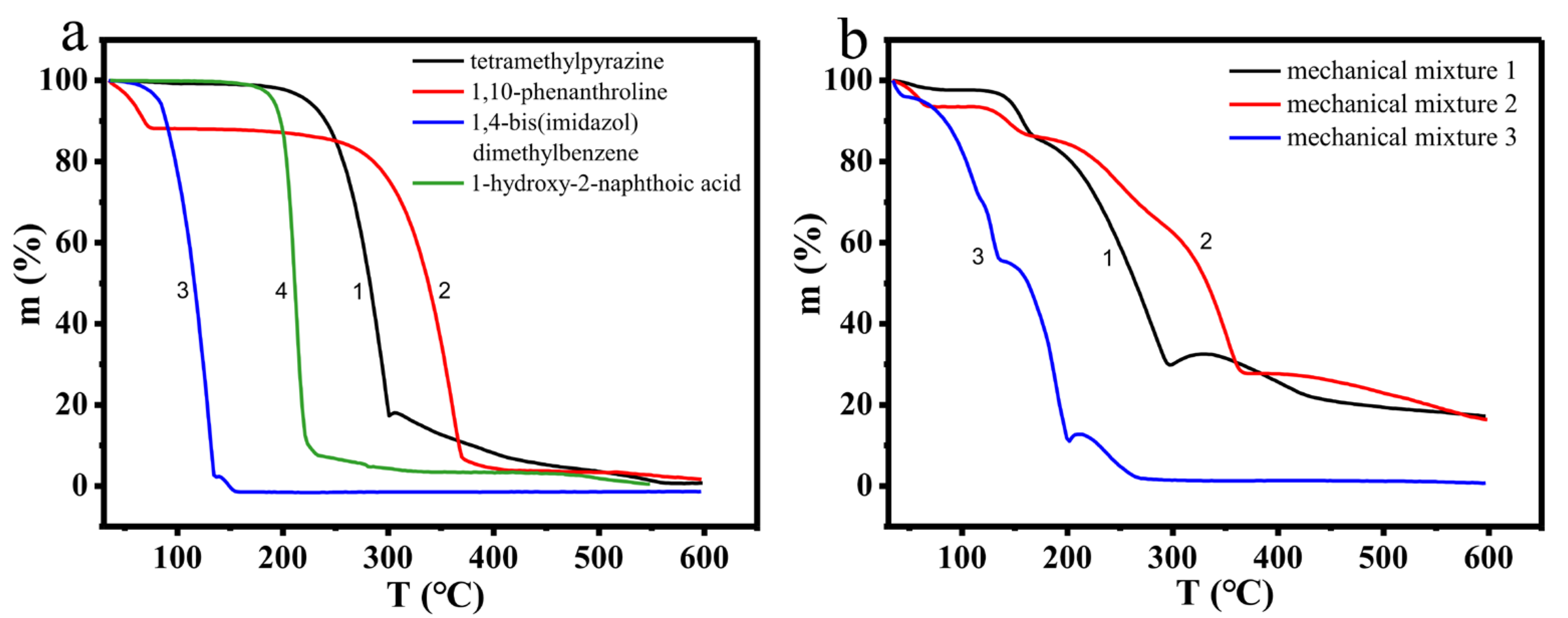
| 1 | 2 | 3 | |
|---|---|---|---|
| Empirical formula M | C15H14NO3 | C34H24N2O6 | C18H15N2O3 |
| 256.27 | 556.55 | 307.32 | |
| Crystal system | Monoclinic | Monoclinic | Monoclinic |
| Space group | P21/c | P21/c | P21/c |
| a/Å | 7.5979(3) | 7.5531(3) | 8.6933(3) |
| b/Å | 20.1355(9) | 32.7203(13) | 9.2525(3) |
| c/Å | 8.7223(5) | 11.3535(5) | 18.8769(5) |
| α/deg | 90 | 90 | 90 |
| β/deg | 106.485(5) | 104.298(5) | 97.675(3) |
| γ/deg | 90 | 90 | 90 |
| V/Å3 | 1279.55(11) | 2719.0(2) | 1504.76(8) |
| Z | 4 | 4 | 4 |
| ρcalcd. (g/cm3) | 1.330 | 1.360 | 1.357 |
| µ (mm−1) | 0.093 | 0.094 | 0.094 |
| F(000) | 540.0 | 1160.0 | 644.0 |
| Total/independent reflections | 5423/2248 | 11,914/4770 | 8030/3556 |
| Data/restraints/parameters | 2248/0/176 | 4770/1/385 | 3556/1/213 |
| Rint | 0.0251 | 0.0296 | 0.0222 |
| R,a Rwb | 0.0526, 0.1577 | 0.0449, 0.1124 | 0.0502, 0.1339 |
| GOF | 1.053 | 1.011 | 0.875 |
| Compounds | D-H···A (Å) | D-H(Å) | H···A(Å) | D···A(Å) | D-H···A (Deg) |
|---|---|---|---|---|---|
| 1 | O3–H3···N1 a | 0.82 | 1.93 | 2.701 | 156 |
| C19–H19B···O2 a | 0.96 | 2.71 | 3.505 | 141 | |
| 2 | N1–H1···O4 b | 0.86 | 1.97 | 2.780 | 157 |
| O6–H6···N2 c | 0.82 | 2.55 | 3.053 | 121 | |
| C27–H27···O6 b | 0.93 | 2.49 | 3.091 | 123 | |
| C28–H28···O5 b | 0.93 | 2.63 | 3.457 | 149 | |
| O5–H5···O1 c | 1.13 | 1.34 | 2.464 | 172 | |
| C35–H35···O3 d | 0.93 | 2.51 | 3.436 | 177 | |
| 3 | C22–H22···O1 e | 0.93 | 2.77 | 3.669 | 163 |
| O1–H1···N2 c | 0.88 | 1.67 | 2.548 | 176 | |
| C20–H20···O1 e | 0.93 | 2.64 | 3.495 | 153 | |
| C17–H17A···O3 e | 0.97 | 2.49 | 3.157 | 126 |
Disclaimer/Publisher’s Note: The statements, opinions and data contained in all publications are solely those of the individual author(s) and contributor(s) and not of MDPI and/or the editor(s). MDPI and/or the editor(s) disclaim responsibility for any injury to people or property resulting from any ideas, methods, instructions or products referred to in the content. |
© 2023 by the authors. Licensee MDPI, Basel, Switzerland. This article is an open access article distributed under the terms and conditions of the Creative Commons Attribution (CC BY) license (https://creativecommons.org/licenses/by/4.0/).
Share and Cite
Qu, H.; Chen, R.; Ma, Y.; Li, N.; Zhang, M.; Yu, Y.; Lv, Z.; Liu, K. The Role of Weak C–H···X (X = O, π) Interactions in Three 1-Hydroxy-2-naphthoic Acid Cocrystals with N-Containing Heteroaromatics: Structural Characterization and Synthon Cooperation. Crystals 2023, 13, 402. https://doi.org/10.3390/cryst13030402
Qu H, Chen R, Ma Y, Li N, Zhang M, Yu Y, Lv Z, Liu K. The Role of Weak C–H···X (X = O, π) Interactions in Three 1-Hydroxy-2-naphthoic Acid Cocrystals with N-Containing Heteroaromatics: Structural Characterization and Synthon Cooperation. Crystals. 2023; 13(3):402. https://doi.org/10.3390/cryst13030402
Chicago/Turabian StyleQu, Huiqi, Ruixin Chen, Yiru Ma, Na Li, Mingjuan Zhang, Yueqin Yu, Zhiguo Lv, and Kang Liu. 2023. "The Role of Weak C–H···X (X = O, π) Interactions in Three 1-Hydroxy-2-naphthoic Acid Cocrystals with N-Containing Heteroaromatics: Structural Characterization and Synthon Cooperation" Crystals 13, no. 3: 402. https://doi.org/10.3390/cryst13030402
APA StyleQu, H., Chen, R., Ma, Y., Li, N., Zhang, M., Yu, Y., Lv, Z., & Liu, K. (2023). The Role of Weak C–H···X (X = O, π) Interactions in Three 1-Hydroxy-2-naphthoic Acid Cocrystals with N-Containing Heteroaromatics: Structural Characterization and Synthon Cooperation. Crystals, 13(3), 402. https://doi.org/10.3390/cryst13030402






